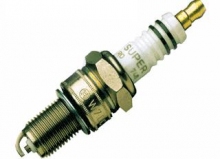The spark plug heat range has no relationship to the electrical energy transferred through the spark plug. The heat range of a spark plug is the range in which the plug works well thermally. The heat rating of each spark plug is indicated by a number; lower numbers indicate a hotter type, higher numbers indicate a colder type.
Heat rating and heat flow path of Spark Plugs
Some basic structural factors affecting the heat range of a spark plug are:
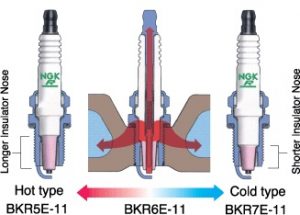 Surface area and/or length of the insulator nose
Surface area and/or length of the insulator nose- Thermal conductivity of the insulator, center electrode, etc.
- Structure of the center electrode such as a copper core, etc.
- Relative position of the insulator tip to the end of the shell (projection)
The major structural difference affecting the heat rating is the length of the insulator nose. A hot type spark plug has a longer insulator nose. The insulator nose of a hotter spark plug has a longer distance between the firing tip of the insulator, and the point where insulator meets the metal shell. Therefore, the path for the dissipation of heat from the insulator nose to the cylinder head is longer and the firing end stays hotter. The insulator nose of a hotter spark plug also has a greater surface area that is exposed to more of the ignited gases and is easily heated to higher temperatures. A colder spark plug functions in an opposite manner.
The heat range must be carefully selected for proper spark plug thermal performance. If the heat range is not optimal, then serious trouble can be the result. The optimal firing end temperature is approximately between 500°C (932°F) and 800°C (1472°F). The two most common causes of spark plug problems are carbon fouling (< 840°F) and overheating (> 1470°F).
Causes of Carbon Fouling:
- Continuous low speed driving and/or short trips
- Spark plug heat range too cold
- Air-fuel mixture too rich
- Reduced compression and oil usage due to worn piston rings / cylinder walls
- Over-retarded ignition timing
- Ignition system deterioration
Pre-delivery fouling
Carbon fouling occurs when the spark plug firing end does not reach the self-cleaning temperature of approximately 450°C (842°F). Carbon deposits will begin to burn off from the insulator nose when the self-cleaning temperature is reached. When the heat range is too cold for the engine speed, the firing end temperature will stay below 842°F and carbon deposits will accumulate on the insulator nose. This is called carbon fouling. When enough carbon accumulates, the spark will travel the path of least resistance over the insulator nose to the metal shell instead of jumping across the gap. This usually results in a misfire and further fouling.
If the selected spark plug heat range is too cold, the spark plug may begin to foul when the engine speed is low or when operating in cold conditions with rich air-fuel mixtures. In some cases, the insulator nose can usually be cleaned by operating the engine at higher speeds in order to reach the self-cleaning temperature. If the spark plug has completely fouled, and the engine will not operate correctly, the spark plug may need to be cleaned / replaced and the fouling cause identified.
Causes of Overheating:
- Spark plug heat range too hot
- Insufficient tightening torque and/or no gasket
- Over-advanced ignition timing
- Fuel octane rating too low (knock is present)
- Excessively lean air-fuel mixture
- Excessive combustion chamber deposits
- Continuous driving under excessively heavy load
- Insufficient engine cooling or lubrication
The most serious result of selecting a heat range that is too hot is overheating. Overheating will cause the electrodes to wear quickly and can lead to pre-ignition. Pre-ignition occurs when the air-fuel mixture is ignited by a hot object/area in the combustion chamber before the timed spark event occurs. When the spark plug firing end (tip) temperature exceeds 800°C, pre-ignition originating from the overheated insulator ceramic can occur. Pre-ignition will dramatically raise the cylinder temperature and pressure and can cause serious and expensive engine damage. When inspecting a spark plug that has experienced overheating or pre-ignition, blistering on the ceramic insulator and/or melted electrodes can sometimes be found.
As a general guideline, among identical spark plug types, the difference in tip temperature from one heat range to the next is approximately 158°F to 212°F.
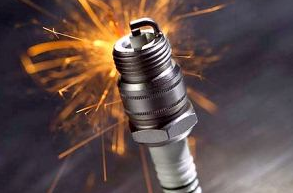 Spark plugs have been around as long as internal combustion engines have, and are often a misunderstood component. This basic guide is designed to assist the technician, hobbyist, or race mechanic in understanding, using, and troubleshooting spark plugs.
Spark plugs have been around as long as internal combustion engines have, and are often a misunderstood component. This basic guide is designed to assist the technician, hobbyist, or race mechanic in understanding, using, and troubleshooting spark plugs.
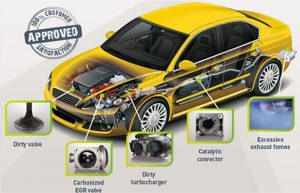 Cleans your engine
Cleans your engine Surface area and/or length of the insulator nose
Surface area and/or length of the insulator nose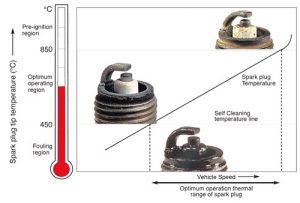 Some factors to consider in selecting the proper heat range spark plug
Some factors to consider in selecting the proper heat range spark plug